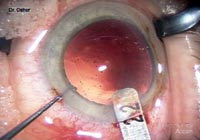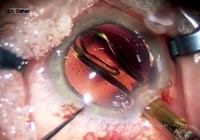Torsional ultrasound technology allows coaxial phaco through 2.2-mm incision
Coaxial phaco with a torsional ultrasound handpiece could replace current cataract technology within 5 years, surgeons predict.
Click Here to Manage Email Alerts
NEW YORK — New technology for performing coaxial microphaco will allow cataract removal through a 2.2 mm incision, according to a leading surgeon. He called the technology “an exciting advance” in phacoemulsification.
Robert H. Osher, MD, a professor of ophthalmology at the University of Cincinnati, said he has been using coaxial microphaco with the Ultra Sleeve from Alcon since February.
“Coaxial microphaco is now my procedure of choice. The Ultra Sleeve was designed to allow the entire cataract procedure to be performed through a 2.2-mm incision. The phacoemulsification has superior fluidics compared to sleeveless bimanual phaco. The incisions are competent, and best of all it is unnecessary to enlarge or add an incision for the IOL. You can insert a full-size IOL through a 2.2-mm incision without compromising design, centration, posterior capsular opacification reduction, macular protection, toric correction and pseudoaccommodative features,” he said during a panel discussion on cataract surgery techniques and technology here at the Ocular Surgery News Symposium.
Dr. Osher said he prefers this technique over sleeveless bimanual phaco.
“There is a world of difference” between the two techniques, he said. “With sleeveless bimanual, which I have tried intermittently for almost 3 years, I have never felt perfectly comfortable because of suboptimal fluidics.”
Dr. Osher added that with coaxial phaco there is no learning curve.
“That is a key advantage,” he said. “There is always a learning curve with sleeveless. With coaxial microphaco, I simply raise the bottle about 25% more. I have not observed surge with my preferred parameters on the [Alcon] Infiniti machine.”
|
|
|
|
|
Images: Osher RH |
During the panel discussion, Richard J. Mackool, MD, commented on the technique.
“This is the closest that Bob and I have ever come to agreeing on any subject in the history of our time together,” he joked. “But I don’t think Bob is putting his bottle is as high as I would like it to be. I use 130 cm to 140 cm of bottle height, 40 cc/min of flow and 400 mm of vacuum. The chamber is very stable. There’s virtually no surge.”
Dr. Osher pointed out that IOL implantation through a 2.2-mm incision is different.
“A one-handed technique with a plunger is necessary,” he said. “I have used the ASICO Royale and the one I developed with Duckworth & Kent. It is necessary to apply countertraction with an instrument through the side port incision as the IOL is injected with confidence through the cartridge, which has entered the incision bevel-down. It is really slick once you get the hang of it.”
Richard L. Lindstrom, MD, program director of the symposium and OSN’s Chief Medical Editor, said, “I think this is a really important advance. I have used bimanual phaco with a very low success rate. I still don’t like bimanual phaco as much [as traditional phaco]. I think a 2.2-mm incision with a standard coaxial system is as much as any of us need.”
New ultrasonic modality
The new Ultra Sleeve requires an upgrade to Alcon’s Infiniti Vision System (Infiniti version 2.0), as well as the torsional handpiece, which oscillates, unlike the back-and-forth motion of traditional ultrasound, according to Dr. Mackool.
Dr. Mackool refers to the new modality as T-phaco. The handpiece, called the OZiL torsional handpiece, has an angulated tip that oscillates at 32,000 kHz/second.
“It can also go back and forth, but thus far oscillation has shown such huge advantages over standard linear phaco that we find no reason to use standard anymore,” he said. “It does not create chattering of nuclear fragments the way standard linear ultrasound does.”
Dense lens fragments
“Denser lens segments are the ones more easily repelled with standard ultrasound,” Dr. Mackool said. “If you punch a pillow, it’s not going anywhere, but if you punch a rock, it’s going somewhere.”
If the surgeon “punches” a lens segment with ultrasound, it can tend to chatter, Dr. Mackool explained.
“It can dance away from you and can strike endothelium, which is clearly an undesirable event,” he said. “Phaco in dense lenses is always more dangerous, but T-phaco is much safer because there is no repellent force.”
Dr. Mackool said he initially thought the torsional modality would be unable to impale and hold the nucleus.
“I was pleasantly surprised that there are no disadvantages,” Dr. Mackool said. “In fact, there are more advantages than I have mentioned.”
The handpiece delivers about three times as much energy at the oscillating angulated tip as along the shaft, Dr. Mackool said.
For Your Information:
- Richard J. Mackool, MD can be reached at 31-27 41st St., Astoria, NY 11103 U.S.A.; +1-718-728-3400; fax: +1-718-728-4882; e-mail: mackooleye@aol.com. Dr. Mackool is a paid consultant for Alcon.
- Robert H. Osher, MD, can be reached at the Cincinnati Eye Institute, 10494 Montgomery Road, Cincinnati, OH 45242 U.S.A.; +1-513-984-5133; fax: +1-513-936-4881; e-mail: rhosher@cincinnatieye.com. Dr. Osher is a paid consultant for Alcon. He has no direct financial interest in the products mentioned in this article.
- Alcon, maker of the Ultra Sleeve, the OZiL Torsional Handpiece and the Infiniti Vision System can be reached at 6201 South Freeway, Fort Worth, TX 76134 U.S.A.; +1-817-293--0450; fax: +1-817-551-9905; Web site: www.alconlabs.com
- Mary E. Archer, ELS, is Executive Editor of Ocular Surgery News U.S. Edition. Daniele Cruz is an OSN Staff Writer who covers all aspects of ophthalmology.




